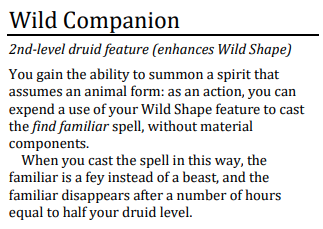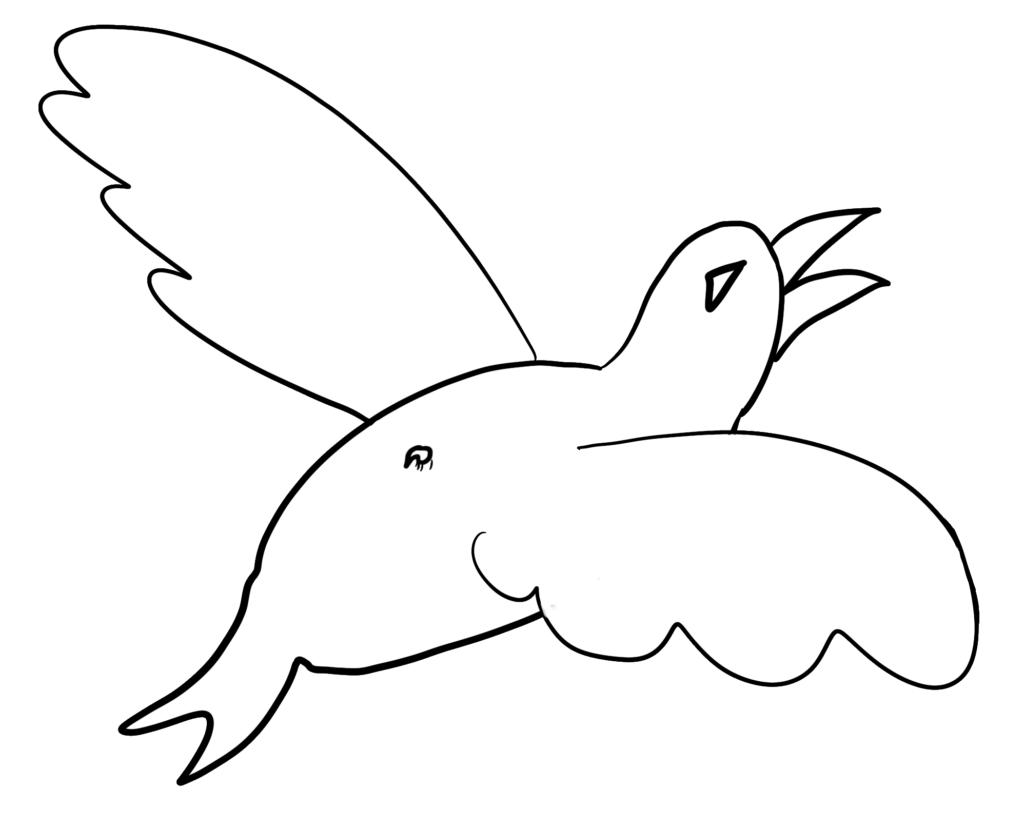D&D: Why Every Druid Should Have a Familiar
In D&D 5e, familiars are normally a wizard/warlock-only thing. You get one through the 1st-level “Find Familiar” spell, which nevertheless behaves pretty differently from most spells. Back in the day, the only way for other classes to obtain a familiar was through specific feats. This was how my druid obtained one, but there’s a new way as well. Tasha’s Cauldron of Everything introduced the “Wild Companion” alternate class feature, which every druid gets for free:

First, I’d like to discuss why I consider familiars one of the best choices you can make in your personal build. Then, let’s go over the main differences between these two ways of obtaining one.
On Familiars
In 5e, familiars aren’t real animals, but ethereal spirits assuming bestial forms. You can communicate with them telepathically, and they’ll follow orders without question. You can see through their eyes up to a range of 100ft, and even cast touch spells through them. When you don’t want it around, you can temporarily dismiss it into a tiny pocket dimension. I think it should be pretty obvious just how versatile and useful all these different functions are. Send them on scouting missions, order them to tail suspicious NPCs, leave them on guard while the party’s asleep, etc.

Familiars have a vast (but fixed) set of animals they can mimic. Which one is always chosen at the moment they’re summoned. This could be considered a downside, as your familiar cannot morph into a new form without spending the cost to re-summon it. In practice, owl is widely considered the most useful and probably your goto during all-purpose situations. But don’t forget that you can summon it as a snake, or octopus, or whatever, if the situation calls for it. It’s pretty much always better to summon a familiar than to Wildshape into these utility animals yourself, since you get to remain humanoid and cast spells/do your own thing in the meantime.
Let’s go over some of my various uses for my familiar:
1. Free poison
The snake familiar can be milked for poison, if you find yourself in a situation where you could use a vial. I guess you could use the octopus for ink in a similar fashion, if you’re not afraid to make a mess.
2. Helping in combat
It’s important to remember that the rules specifically forbid your familiar from attacking. However, any flying familiar can still aid in combat by taking the “help” action. On your turn, have it fly within 5-feet of your target and grant you advantage on your attack. Owls, again, are the preferred form for this trick, since they have the ability “Flyby” which lets them disengage without provoking an attack of opportunity.
(Strictly speaking, they can also use ‘help’ outside of combat to grant you advantage on any skillchecks. But I usually see GMs refuse to accept this unless I can justify what an owl is actually doing to help.)
3. Seeing in the dark
Are you one of the races that doesn’t get darkvision? Summon an owl, have it sit on your shoulder, and see through its eyes! If you’re REALLY far from the light, bat familiars take it to the next level with 60ft of blindsight.
4. Storing items securely
The rules aren’t super clear on the specifics of the familiar’s “pocket dimension” you send them to. Charitable GMs might say you can loan something to your familiar and then dismiss them to make the item safely disappear as well. Even if your GM has a stricter interpretation and nixes that plan, owls and bats can naturally regurgitate the contents of their stomachs, so this may work with items small enough to fit in their gullet. (If you want to avoid the pocket dimension entirely, you can also order them to fly somewhere safe where you can regroup with them later.)
5. A distraction
I often find myself sending my familiar to distract a guard or lure away an NPC. In one memorable occasion I was escaping a failed heist as a weasel, and summoned a weasel familiar that pulled the pursuers’ attention from myself.
6. Trapchecking
You may need to apologize to your familiar after this one. But if you’re worried about a suspicious room, or an untrustworthy source of food, you can always use your familiar to interact with it and see what happens. Better than suffering the consequences yourself!
7. Deliver messages
I’ve used my owl as a messenger on many an occasion. Familiars don’t get tired, and could hypothetically fly cross-country if you really needed your note to go far. They don’t even need to return as you can dismiss it and instantly reappear it next to you. If you need the message to be audible, raven familiars can mimic the sounds you tell it to.
8. Casting touch spells at range
This one’s huge. If your only healing spell is cure wounds, you can still heal faraway teammates by tagging them with your bird. The spell I often find myself using is guidance, granting anyone on my team advantage on their next skill check. My owl just needs to be able to reach them!
I hope I’ve sufficiently demonstrated the sheer versatility of having a familiar. Now, let’s go over the main ways druids can obtain one. Each has pros and cons worth considering:
Option A: Wild Companion
Let’s go over the free option first. By expending one of your two Wild Shape features, you can summon a familiar for a short period of time. The Wildshape cost is far-and-away the biggest drawback, as you only get two of those and they’re important for playing your class role. (Technically, at level 4+ you can summon a familiar, take a short rest, and still have at least an hour before it disappears. But in my experience, adventure-related extenuating circumstances are pretty good at not making that possible.) But outside that, there are some huge upsides to this method of summoning. You don’t have to pay any material cost and you cast it within 6 seconds instead of an hour. This makes your familiar more of a spur-of-the-moment summon where you pop it out when the situation calls for it. It’s also far easier to swap your familiar’s form around on a whim. But despite all these upsides, I prefer the second option:
Option B: Magic Initiate
Taking the ‘Magic Initiate‘ feat grants you two cantrips and one 1st-level spell from another classes’ spell list. If you pick find familiar as that 1st-level spell, you can only cast it once per long rest. But this is a non-issue as your familiar will stick around indefinitely; you may never have to cast the spell again. However, you do need to cough up 10 gold’s worth of materials when you cast it, which can be annoying. Plus this material cost significantly curtails short-term swapping your familiar, or resummoning if it gets killed in combat. (The 1-hour cast time doesn’t help either). These many drawbacks to actually casting the spell discourage frequently shapeshifting your familiar, and I’ve found myself using the owl form 99% of the time, even in situations where I wish I had something else. But the two upsides (your familiar never goes away, and you don’t burn a Wildshape to get it) are more than worth it in my opinion. Half the utilities I’ve mentioned in this article aren’t possible if your familiar disappears after a few hours.
Option C: Ritual Caster
The other feat that can unlock find familiar is Ritual Caster. This feat grants you a ritual spellbook and two 1st-level spells from the casting class of your choice. These spells must have the ‘Ritual’ tag and you can only cast them as rituals, meaning the cast time is 10 minutes longer than usual. For find familiar, which is already an hour, this is a non-issue, but this drawback does force you into out-of-combat spellcasting only. This is why I prefer Magic Initiate, as I love cantrips and combat-casting, but Ritual Caster is still a great feat for druids who want potential access to a ton of extra wizard spells.
Option D: Ring of Spell Storing
This is far and away the least useful of the options. Under no circumstances would I recommend this to a druid; this is more of a workaround for like a martial class or a friendly NPC. But anyone (anyone at all) can obtain a familiar using a ring of spell-storing and a buddy who knows the spell. Pay the buddy 10gp, wait patiently for them to cast find familiar into the ring, then cast it yourself and you get to keep the familiar. Said familiar can never change its form, so choose wisely (*cough* owl), and if your familiar dies, you’ll have to do this all over again to get it back. It is an option, and one that requires no feats or class features beyond a low-grade magic item, so I figured I should mention it. But your ‘wild companion’ feature would override it if you ever used that, so it’s just too temporary to be worth the investment for druids.
As you can see, there are no reasons to go completely familiar-free if you’re a druid. Even if you only use the ‘wild companion’ feature, it’s a very powerful ability you should always keep in mind. You’re already the most versatile class in D&D, familiars just add another swiss-army-knife to your already-incredible toolset!

